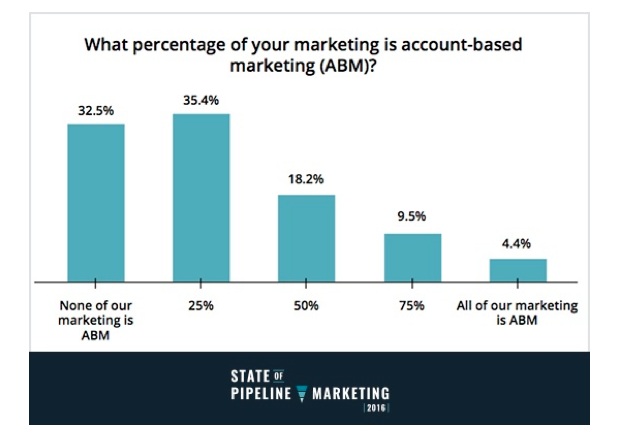7 Myths About Account-Based Marketing Implementation
While account-based marketing has generated a lot of buzz recently, it’s also surrounded by a fair amount of skepticism.
Doubters wonder whether the strategy is actually as new, as effective, and as ‘easy’ as proponents tout it to be. We’re big fans of account-based marketing, but we understand that it’s not a walk in the park to make the switch from demand generation to ABM.

Here are seven myths surrounding account-based marketing, and we’ll be candid in our analysis. As a company that has made a near-100% shift to account-based marketing, we’ve experienced the good, the great, and the admissibly difficult elements of this highly-targeted marketing strategy. And we’d still recommend it, hands down.
MYTH 1 — Account-based marketing is a new concept
Actually, it’s not.
Account-based marketing is the rebirth of an old concept with a far more comprehensive and digitally-based focus. It takes new strategies and capabilities and applies them to old concepts. Account-based marketing is really outbound sales, because you’re specifically targeting account rather than waiting for interested parties to find you first.
However, the difference is how that process is accomplished — what the outreach and engagement looks like and how those interactions are tracked and reported. We’ve wrapped martech and new strategy around a traditional concept, so don’t feel like people are trying to fool you. Yes, there’s a buzz around ABM, but it’s technically nothing new. It’s a highly targeted, data-enriched form of marketing and sales outreach.
That’s not to say it isn’t effective — it is highly effective if done right. And it’s that “new” part of the old approach that causes a dramatic upward shift in win rates and profit margins for myriads of B2B companies.
According to the 2016 State of Pipeline Marketing report, 67% of B2B marketers are doing some form of account-based marketing. And, on average, B2B marketers who do ABM are more tightly aligned with their sales teams.
MYTH 2 — Account-based marketing doesn’t work in cahoots with inbound
Actually, they play nicely together.
Most inbound marketing tactics will cross-apply to an account-based marketing system. This also means that you can run both in tandem, and they don’t get in each other’s way.
While account-based marketing tactics tend to be highly personalized and targeted, many of the same offers, ebooks, articles, webinars, and other marketing activities will also attract potential customers inbound-style.
In the State of Pipeline Marketing report 2016, 35.4% of marketers reported that only 25% of their marketing is ABM — which means that they have account-based marketing strategies and demand generation strategies running alongside each other. And it’s no problem. This also serves as evidence to debunk a third myth about account-based marketing.
MYTH 3 — You have to make an about-face switch to account-based marketing
Actually, you probably shouldn’t.
That same State of Pipeline Marketing report showed that 67.5% of B2B marketers are using account-based marketing strategies in one way or another, but only 4.4% of those marketers have committed 100% to a full-fledged ABM strategy. While an about-face switch to account-based marketing is possible, it requires extensive amounts of preparation, management, auditing, testing, and training. Some companies do it, but it’s a lot to tackle in one go.

Instead, incremental adoption of account-based marketing has been found to be helpful, and some companies never completely forgo demand generation strategies.
There’s one catch — it is difficult to reconcile ABM and demand generation reporting methods. One approach is based on leads, and the other is based on accounts and contacts. It’s nearly impossible to run both types of reporting simultaneously because both require a specific CRM configuration.
So at some point, companies will need to “take the plunge” and switch their reporting from lead-based reports to reports based on contacts and accounts.
MYTH 4 — Account-based marketing is strictly a marketing approach
Actually, it’s for sales, too.
While it’s been dubbed “account-based marketing,” it applies just as much to your sales team as it does to your marketing team. When sales works in a lead-based system, each lead is an isolated entity, separate from his/her company and his/her interactions with their coworkers during the buying process.
An account-based sales approach looks at a company/account holistically. Salespeople tailor their outreach to specific personas in that buying center, and they try to engage as many personas as possible across that account.
MYTH 5 — Moving to account-based marketing won’t require a change to your outreach methodology; it only affects your target list
Actually, a lot will need to change.
This is an entirely different way to sell, and both marketers and salespeople need to be trained on the nuances. Then, they will need new outreach tactics, new workflow sequences, and possibly some new content offers.
Changes in tactics might include more direct mail campaigns, more personalized outreach to higher-ups, and more specific messaging that will appeal to individual personas.
Account-based reporting methods will show the number of times various personas have engaged with marketing content and sales outreach, and advanced reporting systems will provide a predictive engagement score (an algorithmic score based on the engagement from personas across the account).
These are new metrics for your sales team that will inform a new way of selling, and they’ll need to adjust their selling strategy to accommodate the new (and extremely helpful!) information.
MYTH 6 — Account-based marketing will magically solve all of your marketing org’s problems
Actually, it’s not magic. It’s a targeting system.
And, a case could be made that ABM could magnify any strategic issues your organization is currently facing. Because account-based marketing is so highly targeted, you won’t have any “out-of-the-blue wins” that you had with inbound. Your success is based entirely on how well you research, track, reach out, and engage a very specific target audience.
It’s important to make sure that, when your org switches over (at whatever rate you choose), all teams are equipped with the right strategies and martech solutions they need to succeed.
What are some of these needs?
- Marketing automation
- Marketing attribution
- Sales outreach tools
- Data enrichment solution(s)
- CRM integrations between martech / sales solutions
MYTH 7 — Account-based marketing measurement should only focus on engagement, not revenue
Actually, while engagement is important, it’s not the end goal.
Revenue should be the main focus of any account-based marketing strategy. With the emphasis that account-based marketers put on engagement tracking, it’s easy to assume that it’s their single most important metric.
Yet, engagement is a symptom of an underlying intent to buy, so an ABM strategy should be able to link engagement patterns with down-funnel, closed-won customers.
Tracking revenue is critical in account-based marketing, and an attribution solution can help you directly connect your account-based marketing tactics to the revenue they generate. If it’s not followed by a purchase, engagement alone isn’t worth much.
If you’re interested in how to orchestrate a switch to account-based marketing, you can download our ABM Orchestration Template, which gives examples and advice for organizing, prioritizing, and planning an account-based marketing strategy.
Account-based marketing is a powerful, highly-targeted strategy that can eliminate a lot of wasted marketing spend and fruitless sales efforts — as long as it’s implemented properly.